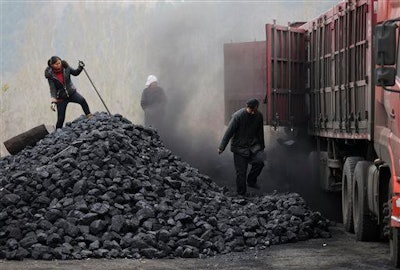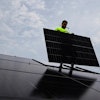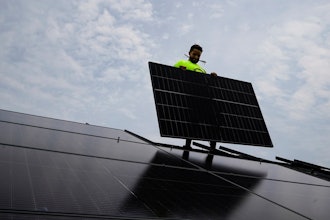
The black slabs of coal came in by the truckload through this dusty valley in northern China, slated to power cement and steel plants, heat the houses of poor farmers and even grill skewers of lamb and beef.
Just a few dozen miles from the capital of Beijing, in Hebei province, coal use has long been a way of life here, with countless house-sized mounds of it dotting the forest floor. Yet the soot-covered residents of Tang County said they see change coming as Chinese leaders pledge to cut back on the kind of rampant coal use that has made this country the world's biggest emitter of greenhouse gases.
Already, Beijing and other Chinese cities have been phasing out coal burning in an attempt to rein in clouds of toxic smog. With much of Beijing's pollution originating from surrounding provinces, Zhao Wei, who works at a coal distributor in Tang County, said it is only a matter of time before those same coal controls hit families here who depend on what remains the cheapest form of heat and energy available.
"If we don't burn coal, what are we going to do?" Zhao asked as his neighbors shoveled coal into grinders and burlap bags. "How will we stay warm in the winter? This will only affect the common people."
Chinese President Xi Jinping officially pushed his country into a less coal-dependent future on Nov. 12 when he pledged to cap the growth of China's carbon emissions by 2030. At the same time, Xi projected China would double the percentage of its energy that comes from non-fossil fuels by that year.
With coal burning by far the biggest contributor to air pollution and carbon emissions in the country, China will have to find other, cleaner ways to power its giant economy if it's going to meet its carbon targets. Coal produces 80 percent of China's electricity and about 60 percent of its total energy supply.
China's coal addiction is a top agenda item this week in Lima, Peru, for the last major round of international negotiations before an important U.N. climate change conference to be held in Paris next year.
"China's policies on coal consumption can have a world-scale implication and impact," said Michael Eckhart, global head of environmental finance for the U.S.-based financial giant Citigroup. "Just the variation in what China can do in the next 20 years has as much impact as all of the emissions of some countries, like Saudi Arabia and Australia and Canada."
With its sheer size, China now emits about twice as much carbon as the United States, the world's second-biggest greenhouse gas polluter. And without major policy changes, China is set to double its greenhouse gas emissions by 2040, according to U.S. Energy Information Administration projections.
Like Eckhart, Chinese authorities say they're optimistic that coal use in China will hit a ceiling as soon as 2020 and then gradually fall over the next decades. Eckhart said nuclear power would likely go farthest in lightening the country's coal burden, as would ramped-up consumer efficiency. Chinese authorities are also trying to move the country's booming economy away from polluting heavy industries to lighter manufacturing and high technology.
"You are seeing a decoupling between addiction to coal and further economic growth," said Li Shuo, Greenpeace East Asia's senior climate and energy officer. "A big part of coal is being replaced by other sources. ... The whole economy is based on less carbon-intensive industries."
Finishing that transition, however, will mean ending business as usual in polluted industrial swaths of China such as Hebei, where nearby mines churn out millions of tons of cheap coal.
So far, Chinese authorities have tried to impose some controls on smokestack emissions and other pollution from some of Hebei's dirtiest plants, said Zhao Liang, a Beijing researcher for a nongovernmental organization called Natural University who has been helping to monitor Hebei's worst polluters. Municipal authorities this year fined one Hong Kong-owned chemical plant about $240,000 because of its wastewater and air emissions.
But some factories have avoided those controls by hiding their pollution, such as letting off air emissions at night when they're harder to detect, Zhao said. On a recent afternoon, several cement plants in Tang County appeared inactive with their smoke stacks unused. Residents there said air pollution just a day before was extreme with vision limited to a few hundred meters (yards).
Environmental authorities have yet to take steps to limit the kinds of industry that's allowed to operate in Hebei, with steel, cement and chemical plants the worst polluters, he said.
"The government isn't regulating everything," Zhao said. "They can't do it 24 hours a day."
Tang County residents said they were most worried that cutting back on coal would hit their pocketbooks, even if it cleaned up the region's notorious smog.
For corn and wheat farmers who earn at best a few thousand dollars a year, coal trucked in from neighboring Shanxi province is still remarkably affordable. A brick of coal costs about a dime, with the average house needing to burn four bricks per day to heat each room. Some people in Tang County also burn corn husks to supplement coal-powered heat.
The government has yet to build the infrastructure for alternative fuels such as natural gas, though there are plans to build more natural gas pipelines into Hebei.
"They're not going to be able to do what they do in Beijing here," truck driver Zhao Zhen predicted, to nods of agreement from several people listening to him on the side of the valley's main road. "We're talking about poor people. There are no pipelines to bring in natural gas. There's no way they'll replace coal."






















